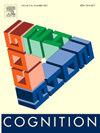The chicken and the egg: unraveling aspects of semantic change and how they relate to lexical acquisition
IF 2.8
1区 心理学
Q1 PSYCHOLOGY, EXPERIMENTAL
引用次数: 0
Abstract
Several recent studies have shown intricate correlations between semantic change and the age of acquisition (AoA) of words, thus reviving the long-standing debate about the relationship between language acquisition and language change, both of which can express weak cognitive biases. However, semantic change can occur in various ways. In this paper, we aim to disentangle different aspects of semantic change and test its relationship to AoA. Specifically, we operationalize semantic change using three different and complementary measures: wiggliness, i.e., a word's tendency to show short-term semantic fluctuation; displacement, i.e., the long-term shift that a word's meaning displays; and diversification, i.e., the degree of polysemy that a word assumes over time. A regression analysis, in which we control for frequency effects, reveals that the three measures of semantic change are associated with AoA, but in opposing ways. Early acquisition is associated with low wiggliness (in particular if frequency is high) and low displacement, but high diversification. Based on a pseudo-causal follow-up analysis involving Bayesian networks, we argue that while early acquisition unidirectionally demotes long-term semantic displacement, there must be a circular ‘chicken-and-egg’ relationship between lexical acquisition and semantic wiggliness and diversification. Differential cognitive mechanisms are necessary to account for these relationships.
鸡和蛋:揭示语义变化的各个方面及其与词汇习得的关系
最近的一些研究表明,语义变化与词汇的习得年龄(AoA)之间存在复杂的相关性,从而重新引发了关于语言习得和语言变化之间关系的长期争论,这两者都可能表达出微弱的认知偏见。然而,语义变化可以以各种方式发生。本文旨在对语义变化的不同方面进行梳理,并检验其与语义语义的关系。具体来说,我们使用三种不同的互补措施来操作语义变化:摆动,即一个词的短期语义波动趋势;移位,即一个词的含义所显示的长期变化;多样化,即一个词随着时间的推移呈现出的多义程度。在我们控制频率效应的回归分析中,我们揭示了语义变化的三种测量方法与AoA相关,但以相反的方式。早期采出与低摆动(特别是如果频率高)和低位移有关,但高度多样化。基于涉及贝叶斯网络的伪因果跟踪分析,我们认为,虽然早期习得单向地降低了长期的语义位移,但词汇习得与语义波动和多样化之间必须存在一个循环的“先有鸡还是先有蛋”的关系。不同的认知机制是解释这些关系的必要条件。
本文章由计算机程序翻译,如有差异,请以英文原文为准。
求助全文
约1分钟内获得全文
求助全文
来源期刊

Cognition
PSYCHOLOGY, EXPERIMENTAL-
CiteScore
6.40
自引率
5.90%
发文量
283
期刊介绍:
Cognition is an international journal that publishes theoretical and experimental papers on the study of the mind. It covers a wide variety of subjects concerning all the different aspects of cognition, ranging from biological and experimental studies to formal analysis. Contributions from the fields of psychology, neuroscience, linguistics, computer science, mathematics, ethology and philosophy are welcome in this journal provided that they have some bearing on the functioning of the mind. In addition, the journal serves as a forum for discussion of social and political aspects of cognitive science.
 求助内容:
求助内容: 应助结果提醒方式:
应助结果提醒方式:


